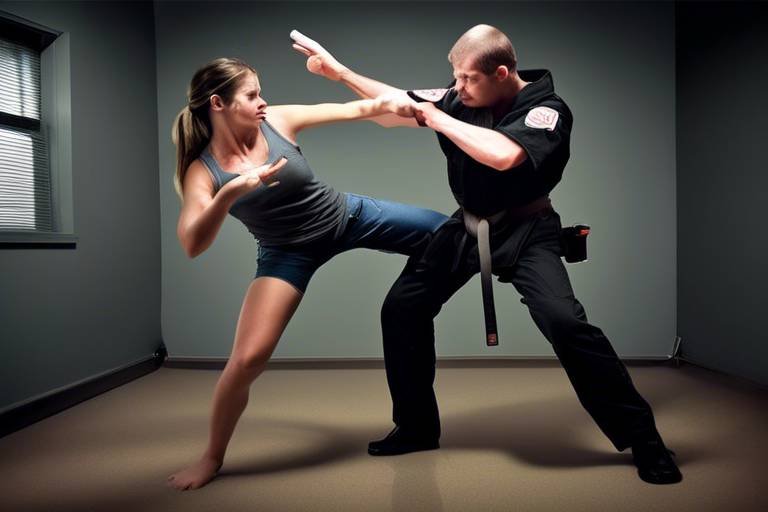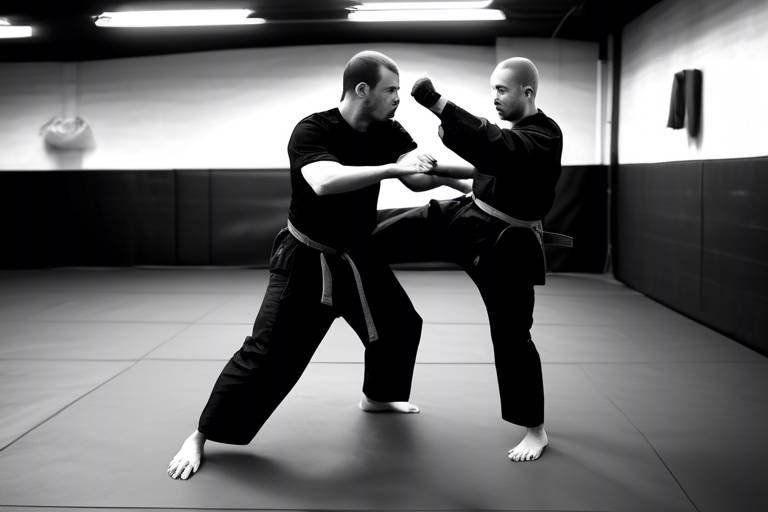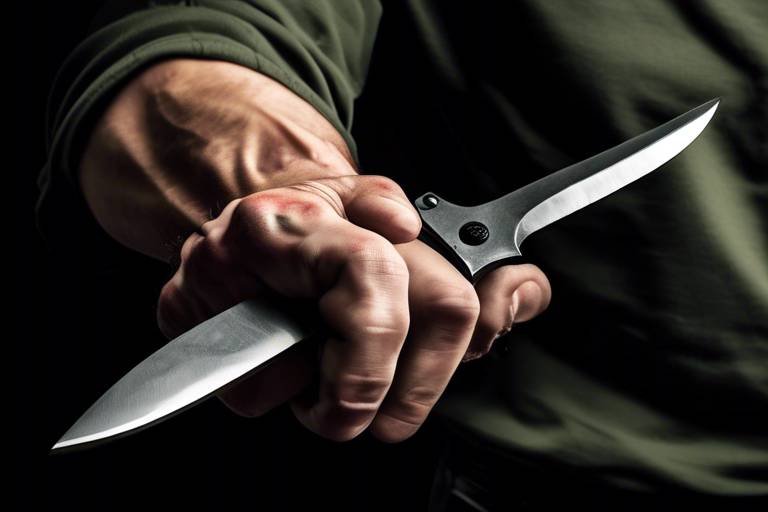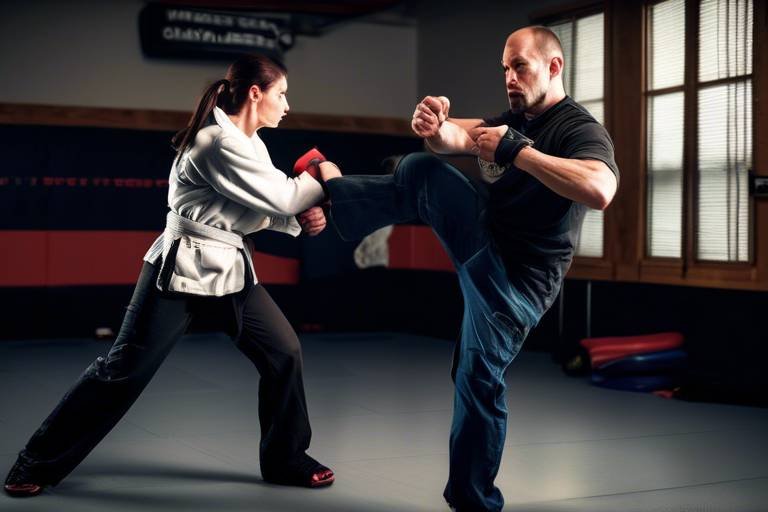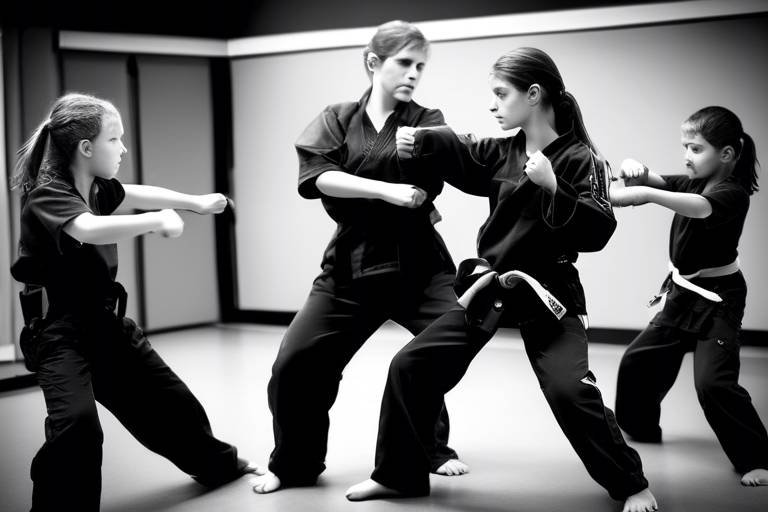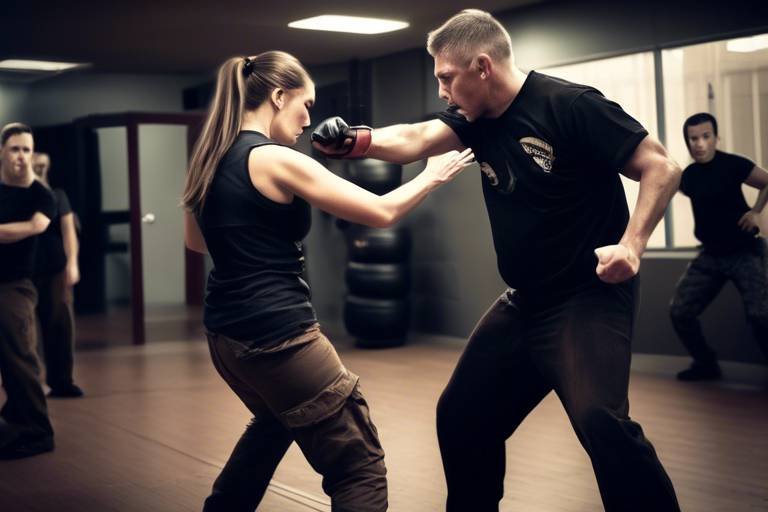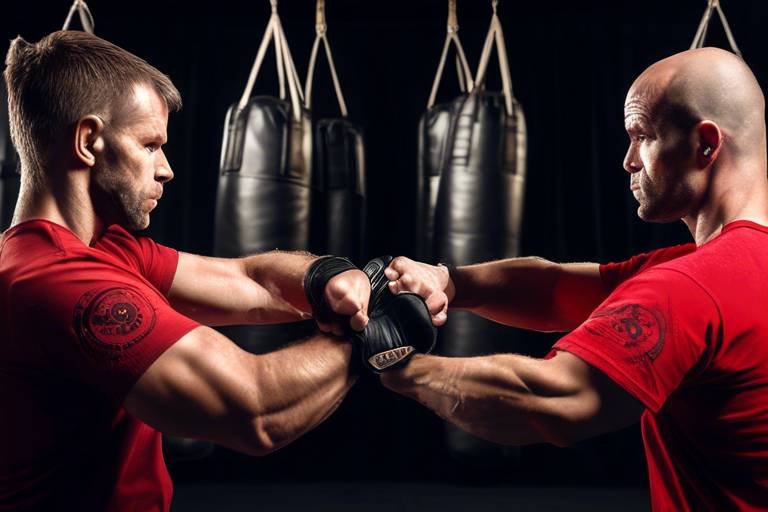Top Five Self-Defense Techniques for Students
This article explores essential self-defense techniques that students can easily learn and apply to protect themselves in various situations, fostering confidence and safety in their daily lives.
Personal safety is crucial for students, as it empowers them to recognize potential threats and respond effectively. In today's world, where unpredictability lurks around every corner, being aware of one’s surroundings is not just a good habit—it’s a necessity. Imagine walking through a crowded campus, headphones in, completely oblivious to the world around you. This is a prime opportunity for trouble to arise. By trusting your instincts and staying alert, you can often sense danger before it escalates.
The palm strike is a powerful self-defense move that can incapacitate an attacker. To execute it effectively, raise your palm and strike the attacker's nose or chin with the heel of your hand. This technique is particularly useful in close-range situations where you might feel cornered. It’s quick, effective, and can create just enough space for you to escape. Remember, the goal is to disable the attacker momentarily, allowing you to make your getaway.
Next up is the knee strike, a technique that targets vulnerable areas of the body, like the groin. When executed correctly, it can cause significant pain and disorientation. To perform this strike, you need to raise your knee sharply into the attacker's groin while simultaneously pushing them away. This move not only incapacitates but also creates an opening for you to flee. The beauty of the knee strike is its simplicity; even in a panic, you can instinctively use it when needed.
In close quarters, the elbow strike can be incredibly effective. This technique is all about using the hard surface of your elbow to deliver a powerful blow to an attacker's face or torso. To execute it, pivot your body and drive your elbow into the target. The key here is to remain calm and focused; a well-placed elbow strike can turn the tide of an altercation in seconds. Imagine it as a quick, sharp jab that can leave an assailant stunned.
Knowing how to escape from an attacker is essential for personal safety. Various escape techniques can be employed depending on the situation. For instance, if someone grabs your wrist, a simple twist and pull can free you. Here are a couple of scenarios:
- If grabbed from behind, lower your body and shift your weight to break the hold.
- If held from the front, use your body weight to push against the attacker while twisting away.
Understanding these maneuvers can be the difference between safety and danger. Always remember, your primary goal is to escape, not to engage.
Ground defense techniques are vital for students who may find themselves on the ground during an altercation. If you end up on your back, it’s important to know how to protect yourself. One effective method is to use your feet to keep distance from the attacker while looking for an opportunity to escape. Additionally, learning how to roll away or use your legs to push the assailant can be invaluable. Ground defense isn’t just about fighting back; it’s about survival and finding a way to get back on your feet.
Regular practice of self-defense techniques boosts confidence and preparedness. It’s like learning to ride a bike; the more you practice, the more natural it becomes. Finding local classes or resources can make all the difference. Many community centers and colleges offer self-defense courses specifically designed for students. Engaging in these classes not only teaches you techniques but also helps you build a support network with others who share your desire for safety.
Understanding the legal implications of self-defense is crucial for students. Each state has different laws regarding what constitutes acceptable self-defense. It’s important to be aware of your rights and the potential consequences of using force. Always remember, self-defense should be a last resort, and understanding when it’s appropriate to use these techniques can protect you legally as well as physically.
Numerous resources are available for students wishing to deepen their self-defense knowledge. Here are a few recommendations:
- Books: Look for titles on self-defense strategies.
- Online Courses: Websites like Udemy offer courses on various self-defense techniques.
- Local Workshops: Check community boards for upcoming self-defense workshops.
Investing time in these resources can empower you with the knowledge and skills needed to protect yourself.
Q: Can anyone learn self-defense?
A: Absolutely! Self-defense techniques are designed for everyone, regardless of physical ability.
Q: How often should I practice?
A: Regular practice is recommended; even a few minutes a week can help reinforce your skills.
Q: Is self-defense legal everywhere?
A: Laws vary by location, so it’s essential to understand the laws in your area regarding self-defense.

Understanding Personal Safety
Personal safety is not just a buzzword; it’s an essential aspect of life for students navigating their way through school, social events, and everyday activities. Imagine walking through a crowded campus or a dimly lit parking lot—being aware of your surroundings can make all the difference. The first step in ensuring your safety is to develop a keen sense of awareness. This means not only being alert to what is happening around you but also trusting your instincts. If something feels off, it probably is!
Consider this: when you’re out and about, your environment is constantly changing. There are people coming and going, sounds that might be alarming, and situations that can escalate quickly. By being aware, you can identify potential threats and take action before they become serious. For instance, if you notice someone following you, it’s crucial to change your route or seek help. Recognizing these signs early can give you the upper hand in a potentially dangerous situation.
Another key aspect of personal safety is understanding the importance of communication. Whether it’s letting friends know your whereabouts or having a trusted contact who knows your routine, staying connected can enhance your safety. In fact, you might find that sharing your plans with a friend can not only keep you safe but also provide a sense of accountability. After all, safety is a community effort!
Moreover, personal safety extends beyond physical threats; it also involves emotional and mental well-being. Engaging in activities that boost your confidence, such as self-defense classes, can empower you. When you feel strong and capable, you radiate an aura of confidence that can deter potential threats. So, ask yourself: how can you take charge of your personal safety today? Whether it’s practicing a few self-defense moves or simply being more observant, every small step counts.
In summary, understanding personal safety is about being aware, communicating effectively, and taking proactive steps to protect yourself. It’s not just about reacting to danger but also about creating an environment where you feel secure and confident. Remember, safety is a journey, not a destination. Start today by cultivating awareness and building your personal safety toolkit!

Technique 1: The Palm Strike
The palm strike is one of the most effective self-defense techniques that anyone, including students, can easily learn and apply. Imagine being in a situation where you feel threatened; the palm strike can be your go-to move to incapacitate an attacker quickly and efficiently. This technique utilizes the natural strength of your palm, which is often overlooked compared to punches or kicks. It's not just about brute force; it's about technique and precision.
To execute a palm strike effectively, follow these simple steps:
- Positioning: Stand with your feet shoulder-width apart, knees slightly bent, and your hands up in a guard position. This stance not only prepares you for the strike but also keeps you balanced.
- Aim: Focus on striking with the base of your palm, targeting sensitive areas of the attacker's body, such as the nose, chin, or throat. These areas are particularly vulnerable and can create a significant impact.
- Strike: With a swift motion, thrust your palm forward, using your body weight to add force. Imagine you're trying to push something away from you; this will help you generate the necessary power.
Timing is crucial when using the palm strike. You want to deliver the strike when the attacker is within arm's reach, catching them off-guard. This technique is especially useful in situations where you need to create space between you and your assailant. By incapacitating them momentarily, you can then make your escape. Think of it as a quick burst of energy that gives you the upper hand in a tense situation.
Additionally, practicing the palm strike can enhance your confidence. Regular training not only helps you master the technique but also conditions your mind to react swiftly in emergencies. You can practice this move on a heavy bag or with a partner, ensuring that you refine your accuracy and power.
In summary, the palm strike is a powerful self-defense maneuver that is easy to learn and apply. It combines simplicity with effectiveness, making it an essential technique for students who want to feel safer in their daily lives. Remember, the key to mastering this technique lies in practice and precision. So, next time you find yourself in a self-defense class, don’t underestimate the power of your palm!

Technique 2: The Knee Strike
The knee strike is an incredibly effective self-defense technique that can be a game changer in a tight spot. Imagine being cornered by an aggressor. Your heart races, and every instinct tells you to fight or flight. In such moments, knowing how to execute a knee strike can turn the tide in your favor. This technique is not only simple to learn but also powerful enough to incapacitate an attacker, giving you the precious seconds needed to escape.
So, how do you perform a knee strike effectively? First, you need to get into a proper stance. Stand with your feet shoulder-width apart, knees slightly bent, and your body relaxed but ready to move. As your opponent approaches, you should aim to close the distance between you and them. This is crucial because the knee strike is most effective at close range. Once you’re in range, lift your knee sharply towards your opponent's midsection or face, using your hips to generate power. This movement is akin to a coiled spring releasing energy—quick and forceful.
It's also essential to target vulnerable areas. The knee strike is particularly effective when aimed at:
- The solar plexus, which can knock the wind out of an attacker.
- The groin, a sensitive area that can cause immediate incapacitation.
- The face, which can disorient and distract the aggressor.
Timing is everything. You want to wait until your opponent is close enough that they feel confident in their approach, then strike with precision. The element of surprise can be your best ally. Remember, the goal is not to engage in a prolonged fight; rather, it’s about creating an opportunity to escape. After executing the knee strike, be prepared to follow up with another technique or to make your exit.
Practicing the knee strike regularly will help you develop muscle memory, making it easier to execute under stress. Consider pairing it with other self-defense techniques, like the palm strike or elbow strike, to create a well-rounded defense strategy. The more you practice, the more confident you’ll become in your ability to protect yourself.
Lastly, always keep in mind that self-defense is about protecting yourself, not about proving your strength. In a dangerous situation, your primary goal is to escape safely. With the knee strike in your arsenal, you’ll feel more equipped to handle potential threats, making your daily life a little less daunting.

Technique 3: The Elbow Strike
The elbow strike is one of the most effective close-range self-defense techniques you can master. Why? Because your elbows are incredibly powerful and can deliver significant force, making them ideal for situations where you find yourself in close proximity to an attacker. Imagine being cornered in a tight space; the elbow strike becomes your best friend. This technique is not only intuitive but also easy to execute, even for those who may not have a background in martial arts.
To perform an elbow strike effectively, you first need to position yourself correctly. Stand with your feet shoulder-width apart, knees slightly bent, and your hands up in a defensive posture. When the moment arises, pivot your body towards your attacker while bringing your elbow up and forward in a swift motion. Aim for vulnerable areas such as the nose, jaw, or ribs. The key is to keep your movements fluid and natural, almost like you're throwing a punch but with your elbow leading the way.
One of the great things about the elbow strike is its versatility. It can be used in various scenarios, whether you're standing or even if you're grappling with someone. Here are some situations where the elbow strike shines:
- Close Quarters Combat: When the distance is too short for a full punch, your elbow can reach your target effectively.
- Defensive Maneuver: If someone is attempting to grab or push you, an elbow strike can create space and help you escape.
- Counterattack: If an assailant is coming at you, using an elbow strike can serve as a powerful counter to disrupt their attack.
Practicing the elbow strike regularly will not only improve your technique but also build muscle memory. Consider incorporating it into your workout routine or practicing with a partner in a safe environment. Remember, the more you practice, the more confident you'll become in your ability to defend yourself.
In conclusion, the elbow strike is a simple yet effective technique that can be a game-changer in self-defense situations. Its power and versatility make it a must-learn for anyone looking to enhance their personal safety. So, whether you're walking across campus late at night or just want to feel more secure in your daily life, mastering the elbow strike could be one of the best decisions you make.

Technique 4: The Escape Maneuver
The escape maneuver is perhaps one of the most vital self-defense techniques a student can master. Imagine being caught in a situation where retreat is your best option; understanding how to effectively escape can mean the difference between safety and danger. This technique is not just about physical moves; it’s about strategy, awareness, and knowing when to act. The key to executing an escape maneuver lies in recognizing the right moment to disengage from a confrontation.
First and foremost, awareness of your surroundings plays a crucial role. Always be alert to potential exits in any environment you find yourself in—be it a classroom, a parking lot, or a party. In a threatening situation, your goal is to create distance between yourself and the attacker. This can often be achieved by using your surroundings to your advantage. For instance, if you find yourself in a tight space, look for obstacles that can slow down your assailant, giving you a chance to escape.
When it comes to executing the escape maneuver, there are several techniques you can employ:
- Footwork: Quick, agile footwork is essential. Practice moving in different directions swiftly to create space. The more you can move, the harder it becomes for an attacker to reach you.
- Body positioning: Always turn your body sideways to make yourself a smaller target. This positioning can also help you pivot quickly in any direction.
- Use of distractions: If possible, create distractions. Throwing an object or making a loud noise can momentarily confuse your attacker, giving you a brief window to escape.
Moreover, it's critical to practice these maneuvers regularly. Just like learning to ride a bike, the more you practice, the more instinctive your reactions become. Enrolling in self-defense classes can provide you with not only the techniques but also the confidence to use them when necessary. Remember, the goal is to escape, not to engage. Always prioritize your safety over proving a point.
In a real-life scenario, consider this analogy: think of yourself as a deer in the woods. When faced with a predator, your instinct is to flee, not fight. This natural response is what you should aim to channel during an escape maneuver. The key is to stay calm, assess the situation, and act swiftly. Practicing these techniques will not only prepare you for potential threats but also instill a sense of confidence that you can carry with you in your daily life.

Technique 5: The Ground Defense
When it comes to self-defense, many students might think that being on the ground is a disadvantage. However, ground defense techniques are essential skills that can turn the tide in a challenging situation. Imagine finding yourself on the ground during an altercation; it’s not just about survival but also about regaining control. Ground defense focuses on using your body effectively, leveraging your position, and employing techniques that can help you escape or defend yourself even when you’re down.
One of the first things to remember is that being on the ground doesn’t mean you’re powerless. In fact, many martial arts teach specific techniques designed for ground fighting. For instance, using your legs can be incredibly effective. By keeping your legs between you and your attacker, you can create a barrier that makes it difficult for them to reach you. This is often referred to as the guard position. From this position, you can either defend yourself or look for opportunities to escape.
Another effective technique is the hip escape. This move allows you to create distance from your attacker. To execute a hip escape, shift your hips away from the opponent while pushing off the ground with your feet. This motion not only creates space but also puts you in a better position to either stand up or perform a counter-move. It’s all about maintaining mobility and using your body to your advantage.
Here’s a quick breakdown of some key ground defense techniques:
- Guard Position: Use your legs to create distance and protect your vital areas.
- Hip Escape: Shift your hips to create space and reposition yourself.
- Submission Holds: If the opportunity arises, you can use holds to control the attacker.
It’s important to practice these techniques regularly. Just like any skill, the more you practice, the more instinctive your responses will become. Consider joining a local martial arts class that focuses on ground defense, such as Brazilian Jiu-Jitsu or Judo. These disciplines emphasize ground fighting and can provide you with the skills to defend yourself effectively.
Lastly, always remember that the goal of ground defense is not to engage in a prolonged fight but to find a way to escape safely. Your priority should always be to get back on your feet and get to safety. By mastering ground defense techniques, you empower yourself with the knowledge and skills to handle unexpected situations with confidence.
Q: What should I do if I find myself on the ground during an attack?
A: Focus on creating distance between you and your attacker using techniques like the guard position and hip escape. Look for opportunities to get back on your feet as quickly as possible.
Q: Are ground defense techniques effective against larger attackers?
A: Yes! Ground defense techniques can be very effective regardless of the size of the attacker. The key is to use leverage and positioning to your advantage.
Q: How can I learn these techniques?
A: Consider enrolling in a local martial arts class that specializes in ground fighting, such as Brazilian Jiu-Jitsu. Many classes also offer beginner-friendly sessions.

Building Confidence through Practice
When it comes to self-defense, confidence is your best ally. The more you practice, the more comfortable you become with the techniques, and this familiarity can make all the difference in a real-life situation. Imagine standing your ground, knowing exactly how to react if confronted. This feeling of empowerment can be life-changing, especially for students navigating the often unpredictable environments of schools and campuses.
Regular practice not only hones your skills but also ingrains muscle memory, allowing you to execute moves instinctively when it counts. Think of it like learning to ride a bike: at first, it’s wobbly and uncertain, but with each ride, you gain stability and confidence. In self-defense, this translates to being able to respond quickly and effectively without second-guessing yourself.
To truly build confidence, consider the following strategies:
- Join a Class: Look for local self-defense classes or martial arts studios. Being part of a group can provide motivation and a sense of community.
- Practice Regularly: Set aside time each week to practice your techniques. Consistency is key to improvement.
- Train with a Partner: Practicing with a friend can simulate real-life scenarios and make training more enjoyable.
- Visualize Success: Mental rehearsal can be just as powerful as physical practice. Visualizing yourself successfully executing techniques can boost your confidence.
Moreover, tracking your progress can also enhance your confidence. Consider keeping a journal of your training sessions, noting what you've learned and areas where you feel you've improved. This not only helps you see how far you've come but also motivates you to keep going. You could even create a simple table to log your sessions, such as:
| Date | Technique Practiced | Notes |
|---|---|---|
| 01/10/2023 | Palm Strike | Felt more comfortable with execution. |
| 01/17/2023 | Knee Strike | Improved targeting accuracy. |
| 01/24/2023 | Elbow Strike | Need to work on follow-through. |
In conclusion, building confidence through practice is not just about learning techniques; it's about cultivating a mindset of resilience and self-assurance. With each practice session, you’re not just preparing for potential threats; you’re also empowering yourself to face challenges with a newfound strength. So gear up, find a partner, and start practicing—your future self will thank you!
Q: How often should I practice self-defense techniques?
A: Ideally, you should practice at least once a week to maintain and improve your skills. Consistency helps in building muscle memory.
Q: Can self-defense training help with self-esteem?
A: Absolutely! Many individuals find that learning self-defense boosts their self-esteem and confidence, as they feel more prepared to handle difficult situations.
Q: Do I need to be physically fit to learn self-defense?
A: Not at all! Self-defense techniques can be adapted to various fitness levels. The key is to focus on technique and practice regularly.
Q: What should I wear to self-defense classes?
A: Comfortable clothing that allows for movement is ideal. Athletic wear or loose-fitting clothes are usually best.

Legal Considerations in Self-Defense
When it comes to self-defense, understanding the legal implications is just as crucial as mastering the techniques themselves. After all, you want to ensure that while you're defending yourself, you’re also staying within the bounds of the law. Many students may not realize that the laws regarding self-defense can vary significantly from one jurisdiction to another. Therefore, it’s essential to familiarize yourself with the laws specific to your area.
Generally, self-defense laws are based on the principle of reasonable force. This means that your response to an attack must be proportional to the threat you are facing. For instance, if someone pushes you, using a weapon in retaliation would likely be considered excessive and could lead to legal repercussions. On the other hand, if someone is threatening you with serious harm, using physical force to defend yourself could be justified.
Here are a few key points to consider when thinking about self-defense laws:
- Imminent Threat: You can only use force if you believe an attack is imminent. If the threat has passed, using force could be seen as retaliation.
- Duty to Retreat: In some states, you are required to retreat from a situation if it is safe to do so before using force. However, this is not the case in all jurisdictions.
- Stand Your Ground Laws: These laws allow individuals to use force without retreating if they feel threatened, but the specifics can vary widely.
Moreover, it’s crucial to document any self-defense incident thoroughly. If you are involved in a confrontation, try to gather evidence, such as witness statements, photographs of injuries, or any other relevant information. This documentation can be invaluable if you find yourself facing legal scrutiny after defending yourself.
Additionally, many self-defense classes include a section on the legal aspects of self-defense. These classes can provide you with a comprehensive understanding of your rights and responsibilities. Remember, knowing the law is not just about protecting yourself physically; it’s also about ensuring that you are legally protected after an incident.
In conclusion, while developing your self-defense skills is vital, equally important is understanding the legal landscape surrounding those skills. Knowledge is power, and being informed can help you navigate any situation with confidence and clarity.
Q: What should I do if I have to use self-defense?
A: If you find yourself in a situation where you need to use self-defense, prioritize your safety first. After ensuring you are safe, contact the authorities to report the incident. It’s advisable to seek legal counsel to understand your rights and responsibilities regarding the situation.
Q: Can I use self-defense if I feel threatened but haven't been attacked?
A: Self-defense laws typically require an imminent threat of harm. If you feel threatened but have not been attacked, using force may not be legally justified. It's best to retreat and seek help if possible.
Q: Are there any self-defense techniques that are illegal?
A: Yes, certain techniques may be considered illegal, especially those that cause excessive harm or involve weapons. It's essential to understand the laws in your jurisdiction regarding self-defense methods.

Resources for Further Learning
As you embark on your journey to master self-defense techniques, it's essential to have access to a variety of resources that can enhance your skills and knowledge. Whether you're a beginner or looking to refine your existing skills, there are plenty of options available to help you grow. Books are a fantastic starting point. They offer in-depth insights into techniques, psychology, and strategies that can be vital for personal safety. For instance, titles like The Gift of Fear by Gavin de Becker provide not only practical advice but also a deeper understanding of how to read situations and people.
In addition to books, online courses have become increasingly popular, allowing students to learn at their own pace from the comfort of their homes. Websites like Udemy and Coursera offer a range of self-defense courses, covering everything from basic techniques to advanced strategies. These platforms often provide video demonstrations, which can be very helpful for visual learners.
If you prefer hands-on experience, consider enrolling in local self-defense classes. Many community centers and martial arts studios offer classes specifically designed for students. These classes not only teach techniques but also build confidence and situational awareness. You can often find classes tailored for different age groups and skill levels, making it easier to find the right fit for you.
Another valuable resource is joining a local self-defense group or club. Being part of a community can motivate you to practice regularly and learn from others' experiences. It’s also a great way to meet like-minded individuals who share your interest in personal safety. Many clubs organize workshops and seminars that can provide additional learning opportunities.
Lastly, don't underestimate the power of online forums and communities. Websites like Reddit have dedicated subreddits where individuals share their experiences, tips, and advice on self-defense. Engaging in these discussions can provide you with practical insights and even some unexpected techniques that you might not find in traditional resources.
To summarize, here’s a quick table of the resources mentioned:
| Resource Type | Examples |
|---|---|
| Books | The Gift of Fear by Gavin de Becker |
| Online Courses | Udemy, Coursera |
| Local Classes | Community centers, Martial arts studios |
| Self-Defense Groups | Local clubs, Workshops |
| Online Communities | Reddit forums |
By utilizing these resources, you'll not only enhance your self-defense skills but also foster a greater sense of confidence and awareness in your daily life. Remember, the journey to personal safety is ongoing, and the more you learn, the better prepared you'll be to handle any situation that comes your way.
Q: How long does it take to learn self-defense techniques?
A: The time it takes to learn self-defense techniques varies by individual and the complexity of the techniques being learned. With consistent practice, many people can grasp basic techniques within a few weeks.
Q: Do I need to be physically fit to learn self-defense?
A: While being in good physical shape can be beneficial, self-defense techniques can be adapted for individuals of all fitness levels. Many techniques focus on leverage and strategy rather than brute strength.
Q: Are self-defense classes safe?
A: Yes, reputable self-defense classes prioritize safety. Instructors typically ensure a controlled environment where students can practice techniques without risk of injury.
Q: Can self-defense training help with confidence?
A: Absolutely! Learning self-defense techniques can significantly boost your confidence by equipping you with the skills and knowledge to protect yourself in various situations.
Frequently Asked Questions
- What are the basic self-defense techniques every student should know?
Every student should be familiar with techniques like the palm strike, knee strike, elbow strike, escape maneuvers, and ground defense. These techniques are simple to learn and can be effective in various situations, helping to build confidence and enhance personal safety.
- How can I practice self-defense techniques safely?
Practicing self-defense techniques can be done safely by working with a partner in a controlled environment, such as a self-defense class. Always ensure that both you and your partner are aware of your limits and use protective gear if necessary. Regular practice will help you become more proficient and confident.
- Is it legal to use self-defense techniques?
Yes, self-defense techniques are legal to use, but the laws surrounding self-defense can vary by location. It's essential to understand the laws in your area regarding the use of force and when it is justified. Always prioritize de-escalation and escape whenever possible.
- Where can I find self-defense classes or resources?
You can find self-defense classes at local community centers, martial arts studios, or through universities. Additionally, many online platforms offer courses and tutorials that you can follow at your own pace. Look for resources that provide structured learning and practical exercises.
- How do I build confidence in my self-defense skills?
Building confidence in your self-defense skills comes from consistent practice and training. The more you train, the more comfortable you will feel applying the techniques in real-life situations. Additionally, understanding the principles of personal safety and awareness can further boost your confidence.


